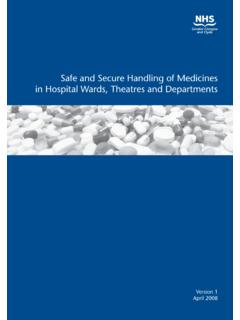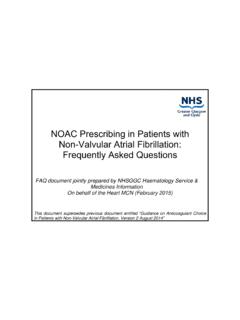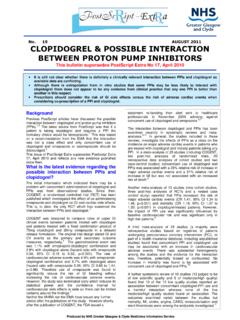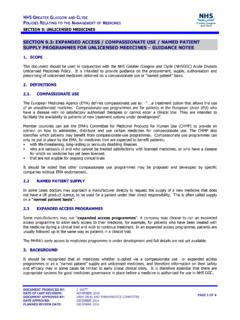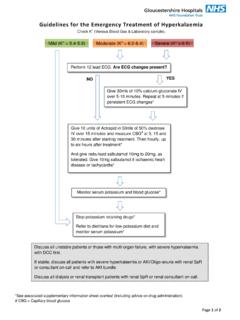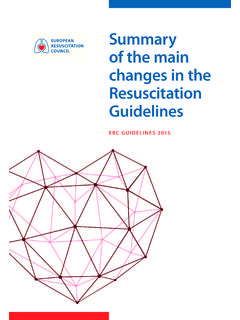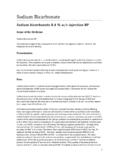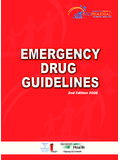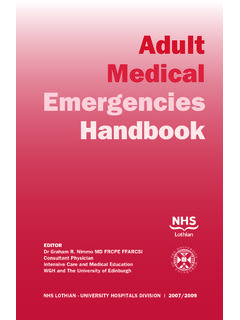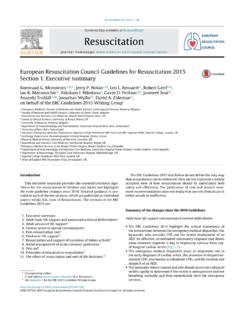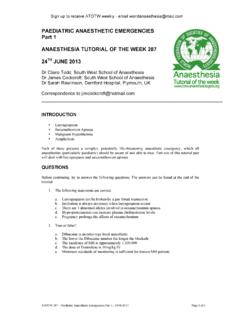Transcription of 1. Drug Interactions - GGC Prescribing
1 Issue 11, June 2013 Produced by NHS Greater Glasgow and Clyde Medicines Information Service and PPSU Clinical Governance Team In this issue: Drug Interactions Management of haemorrhage, surgery or other invasive procedures in patients receiving the newer oral anticoagulants Treatment of urinary tract infection new advice Learning from incidents Guideline news NHSGGC Prescribing App coming soon! Information included is specific to the use of medicines in the adult setting. 1. Drug Interactions A drug interaction occurs when the effects of a drug are altered by the presence of another drug, chemical or food. Drug Interactions are very common and some can have very serious, even fatal adverse consequences.
2 Prescribers must be particularly vigilant when Prescribing new drugs. This is especially true within the acute sector where the lack of an electronic Prescribing system means Interactions are not automatically flagged at the point of Prescribing . Prevalence studies suggest that between 15% and 45% of hospital inpatients are prescribed drugs that interact. Some interacting combinations may be appropriate with close monitoring; however others should be avoided altogether. Snapshot audits undertaken within NHSGGC have identified significant drug Interactions with medicines that should not be co prescribed. The case examples below illustrate that there can be numerous drug interaction issues to consider when introducing new drugs at the point of admission.
3 Case Example 1: Mrs HR has a history of recurrent DVT and essential tremor. She takes bisoprolol 5 mg daily and is stabilised on warfarin (INR checked every 4 weeks). She also takes simvastatin 40 mg at night. She is admitted to hospital with suspected pneumonia (patient is penicillin allergic) which is treated with oral clarithromycin. She also has associated fast AF which is managed with IV amiodarone. Interaction Management Amiodarone and clarithromycin can both independently prolong the QTc interval. Combined therapy may have additive effects. Avoid where possible. Consider monitoring of QTc if combination cannot be avoided. Increased risk of bradycardia, AV block and myocardial depression when amiodarone given with beta blockers.
4 Concurrent use is not recommended or should be undertaken with caution. If continued, monitor for bradycardia. Increased risk of myopathy when amiodarone given with simvastatin. Maximum dose of simvastatin is 20 mg daily if co prescribed amiodarone. Increased risk of myopathy when clarithromycin given with simvastatin. Avoid combination. If clarithromycin is taken for a short course, withhold the simvastatin temporarily. Amiodarone inhibits the metabolism of warfarin resulting in an enhanced anticoagulant effect. Monitor INR closely. Warfarin may require dose reduction as per INR. Clarithromycin inhibits the metabolism of warfarin resulting in an enhanced anticoagulant effect.
5 Monitor INR closely. Warfarin may require dose reduction as per INR. The above example illustrates that some drug Interactions can be managed with extra monitoring, however, others should be avoided. In this particular patient, it may be more appropriate to prescribe an alternative antibiotic doxycycline (refer to NHSGGC infection management guidelines for appropriate choice). 1 PostScript Acute Produced by NHSGGC Medicines Information Services Issue 11, June 2013 1. Drug Interactions (cont d) Case Example 2: Mr AT has a history of epilepsy which is managed with sodium valproate M/R 600 mg twice a day.
6 He presents with pyrexia and rigors. Gram negative bacilli is detected from blood cultures and treated with meropenem. The patient experienced increased seizure activity and reduced consciousness. Serum valproate blood concentration levels were checked and were found to be low. Interaction Management Meropenem (and other carbapenems) can dramatically reduce the serum concentration of valproate. The exact mechanism for the interaction is unknown. o Avoid where possible and seek an alternative antibiotic, discuss with microbiology or an infection specialist o If a carbapenem is the only suitable therapy, seek neurology advice straight away. The interaction is not always successfully managed by an increased valproate dose and an alternative anticonvulsant may be appropriate.
7 The above example illustrates the importance of checking for drug Interactions before Prescribing a new drug and seeking a more appropriate alternative when necessary to prevent drug interaction related adverse effects. 2. Management of haemorrhage, surgery or other invasive procedures in patients receiving the newer oral anticoagulants The NHSGGC Thrombosis Committee has produced guidance for the management of haemorrhage, surgery or other invasive procedure in patients receiving either dabigatran, rivaroxaban or apixaban. These guidelines are available via the Intranet. NOTE: All patients commenced on a newer oral anticoagulant agent will receive a PATIENT ALERT CARD at discharge, which provides patient information and advice if bleeding is experienced.
8 The card should be carried with the patient at all times and shown to any other healthcare professional looking after them pharmacist or dentist. 3. Treatment of urinary tract infection new advice The NHSGGC Antimicrobial Utilisation Committee have endorsed a new recommendation from the Renal Physicians to avoid the use of trimethoprim in hospitalised patients with an eGFR of < 30 ml/ This advice is in response to issues highlighted within the renal unit particularly in patients with stage 4 or 5 chronic kidney disease (CKD). There has been a number of CKD 4 or 5 patients referred to the unit who have developed hyperkalaemia and increased creatinine levels whilst receiving trimethoprim.
9 The NHSGGC advice for hospitalised patients is as follows: Avoid trimethroprim if eGFR < 30 ml/ Check for drug Interactions at: o BNF Appendix 1 o Stockley s Drug Interactions Access via The Knowledge Network (Athens password required) o Individual Summary of Product Characteristics (SPC) via o Clinical Pharmacist or Medicines Information If eGFR < 30 ml/ prescribe o co amoxiclav 625 mg oral 12 hourly (unless true penicillin / beta lactam allergy) If eGFR< 30ml/ and true penicillin / beta lactam allergy prescribe o ciprofloxacin 250 mg oral 12 hourly (remember: ciprofloxacin can cause QTc prolongation check for Interactions ) NOTE: If eGFR < 10 ml/ seek renal advice regarding antibiotic choice and dose This advice will be highlighted in the updated version of the Therapeutics Handbook (due out August 2013).
10 4. Learning from incidents: drug name mix ups Case 3: Hydroxychloroquine/hydroxycarbamide confusion A patient was prescribed hydroxychloroquine 1 gram daily. This dose was not administered as it was higher than the normal dose and it did not fit with the patient s medical condition of polycythaemia. Both the completed Medicines Reconciliation (Meds Rec) form and the patient were consulted to confirm that the prescribed drug should have been hydroxycarbamide 1 gram daily. In April, the MHRA issued a safety alert on drug name confusion and the need for vigilance to prevent life threatening errors. Drug name mix ups have also been reported within NHSGGC. Some case examples and the associated learning points are detailed below.

